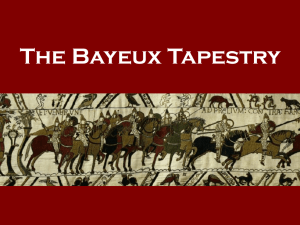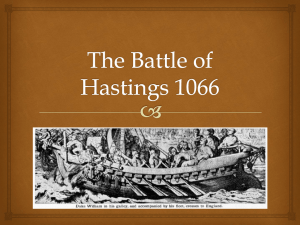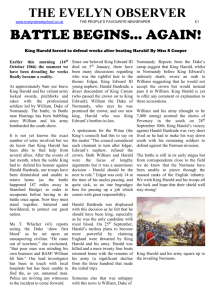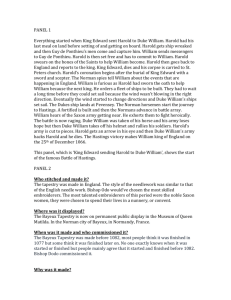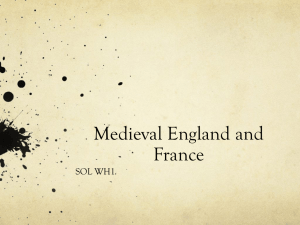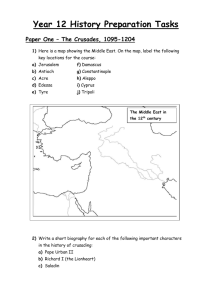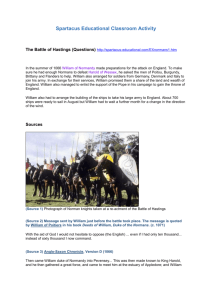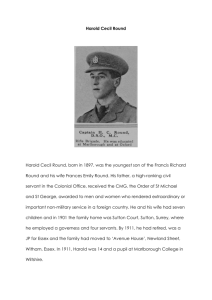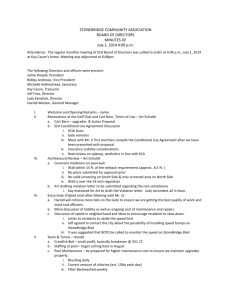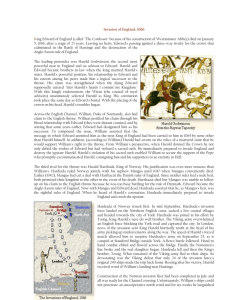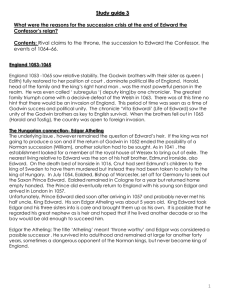File - REPUBLIC OF CALLAMARI
advertisement
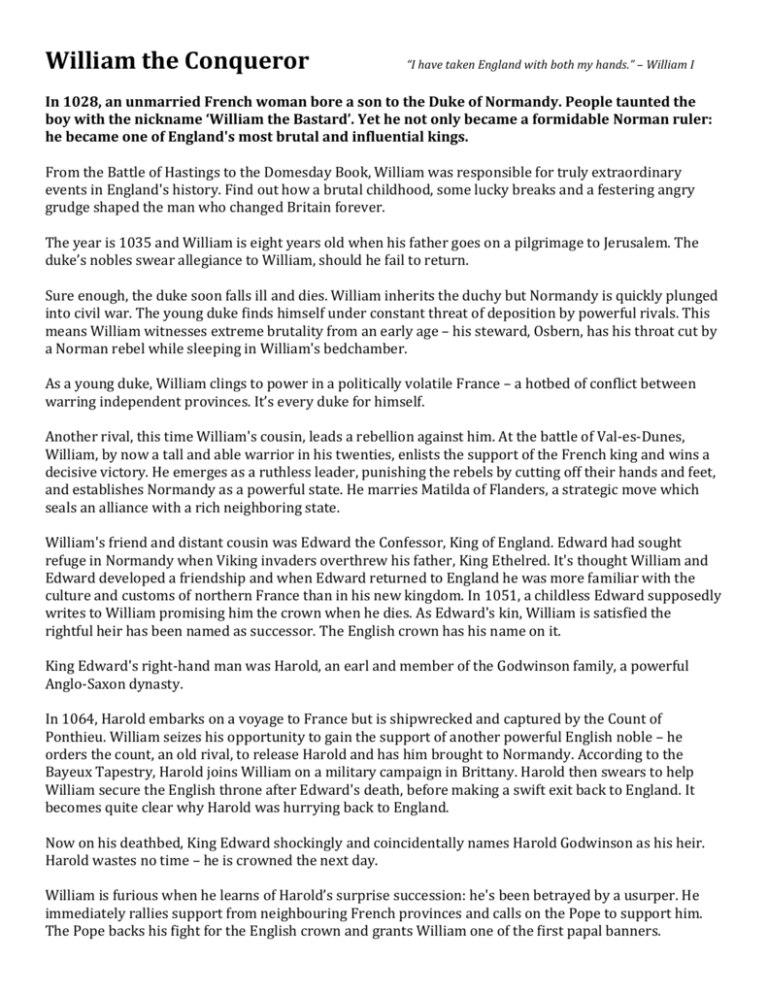
William the Conqueror “I have taken England with both my hands.” – William I In 1028, an unmarried French woman bore a son to the Duke of Normandy. People taunted the boy with the nickname ‘William the Bastard’. Yet he not only became a formidable Norman ruler: he became one of England's most brutal and influential kings. From the Battle of Hastings to the Domesday Book, William was responsible for truly extraordinary events in England's history. Find out how a brutal childhood, some lucky breaks and a festering angry grudge shaped the man who changed Britain forever. The year is 1035 and William is eight years old when his father goes on a pilgrimage to Jerusalem. The duke’s nobles swear allegiance to William, should he fail to return. Sure enough, the duke soon falls ill and dies. William inherits the duchy but Normandy is quickly plunged into civil war. The young duke finds himself under constant threat of deposition by powerful rivals. This means William witnesses extreme brutality from an early age – his steward, Osbern, has his throat cut by a Norman rebel while sleeping in William's bedchamber. As a young duke, William clings to power in a politically volatile France – a hotbed of conflict between warring independent provinces. It’s every duke for himself. Another rival, this time William's cousin, leads a rebellion against him. At the battle of Val-es-Dunes, William, by now a tall and able warrior in his twenties, enlists the support of the French king and wins a decisive victory. He emerges as a ruthless leader, punishing the rebels by cutting off their hands and feet, and establishes Normandy as a powerful state. He marries Matilda of Flanders, a strategic move which seals an alliance with a rich neighboring state. William's friend and distant cousin was Edward the Confessor, King of England. Edward had sought refuge in Normandy when Viking invaders overthrew his father, King Ethelred. It's thought William and Edward developed a friendship and when Edward returned to England he was more familiar with the culture and customs of northern France than in his new kingdom. In 1051, a childless Edward supposedly writes to William promising him the crown when he dies. As Edward's kin, William is satisfied the rightful heir has been named as successor. The English crown has his name on it. King Edward's right-hand man was Harold, an earl and member of the Godwinson family, a powerful Anglo-Saxon dynasty. In 1064, Harold embarks on a voyage to France but is shipwrecked and captured by the Count of Ponthieu. William seizes his opportunity to gain the support of another powerful English noble – he orders the count, an old rival, to release Harold and has him brought to Normandy. According to the Bayeux Tapestry, Harold joins William on a military campaign in Brittany. Harold then swears to help William secure the English throne after Edward's death, before making a swift exit back to England. It becomes quite clear why Harold was hurrying back to England. Now on his deathbed, King Edward shockingly and coincidentally names Harold Godwinson as his heir. Harold wastes no time – he is crowned the next day. William is furious when he learns of Harold’s surprise succession: he's been betrayed by a usurper. He immediately rallies support from neighbouring French provinces and calls on the Pope to support him. The Pope backs his fight for the English crown and grants William one of the first papal banners. Believing God is on his side and with a fleet of 700 ships poised for departure, he waits for favourable winds before setting off for England. The nation’s future will be decided on the battlefield. William arrives on the Sussex coast while King Harold is in the north of England, fighting Viking invaders at the Battle of Stamford Bridge. Harold marches his troops 200 miles south to meet the Norman invaders in Hastings. Although his men are tired, the battle is closely fought: at various points, both leaders are feared dead. It’s brutal and bloody – thousands are slaughtered. At dusk, the Normans finally overcome the English and Harold is killed when an arrow lodges in his eye. William is crowned in Westminster Abbey on Christmas Day. To cement his kingship, William creates a new Norman aristocracy. Castles are built to protect the new nobles and flaunt their power. These nobles will help William rule over his vast lands and new subjects – enter Feudalism. Arguably one of the most important aspects of William’s reign, feudalism will be brought from continental Europe to England and be established as the accepted societal hierarchy. With it brings concepts of contractual government, the very foundation for future constitutional government as based on a social contract. Yet the north continues to cause William problems. After a series of rebellions, he decides to force it into submission and unite England through a campaign of terror and brutality. He lays waste to English villages and destroys farmlands, robbing agricultural communities of their livelihoods. When famine sets in there are tales of people eating dogs, cats and even human flesh to survive. With 100,000 dead, it will be decades before the north recovers from such systematic devastation. William's ruthless leadership has achieved some stability in England. Emboldened, he explores territory beyond his kingdom's borders. He builds castles along the Welsh border and in 1072, reaches a truce with Scotland’s King Malcom III who agrees to recognize William as his lord. In 1075, he quashes the last serious revolt by English nobles and marriages between French-speaking Normans and Anglo-Saxons become common, beginning a melding of cultures still evident in the English language of today. Words including onion, pork, beef and mushroom derive from the French nobility. William’s next achievement was an unparalleled undertaking in medieval history – a vast survey of all the land and holdings in England. An incredible display of Norman efficiency, the country-wide survey was finished in six months. It records the transfer of power from the old Anglo-Saxon elite to the Normans - now only 5% of land was in English hands. His motives are unclear, but it’s thought Domesday was a way of legitimizing William’s kingship while also enabling him to collect taxes more effectively in order to fund his wars. Whatever its purpose, nothing of its kind and scale would be produced again until the 19th Century. Much of the last portion of William's life is spent back in Normandy, hunting and indulging his generous appetite. In 1087 William is riding through the plundered town of Mantes when his large stomach is thrown against his saddle. The injury proves fatal. At his funeral, his stomach explodes: the priest rushes the funeral rites to escape the stench. Despite this undignified end, William's legacy endures – the English language is transformed, the Domesday Book completed and most importantly, power shifted from Northern to Western Europe with the spread of feudalism. It is another 300 years before an Englishspeaking king is crowned in Westminster Abbey. BBC iWonder Series: William The Conqueror

